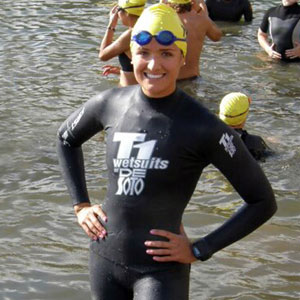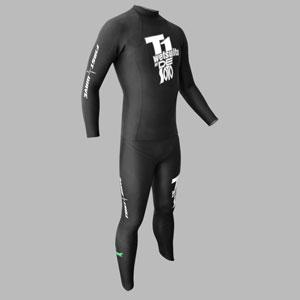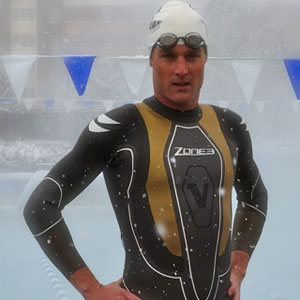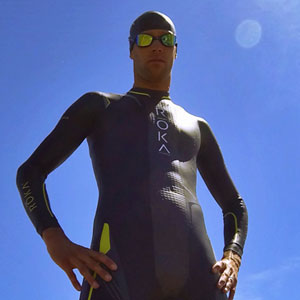T1 by De Soto

As you may have noted last week we're into a wetsuit groove. I began the series talking about a couple of brands that are more recent to the U.S. market, ROKA and Zone3. Then I wrote about Aquaman and I called it "old school" and I hope everybody understands that when I say old school that is very likely to be a compliment (and it was a compliment in Aquaman's case).
ROKA is admirably old school in the sense that its founders and principals dived headlong into the art of wetsuit manufacture: pattern making, seam construction and the like. I honor that. Rocket Science Sports' founder, Marcin Sochacki, dove in so deep he up and moved to China, where most of these wetsuits are made. I just love that attachment to the craft. If you really want to make a great product you have to have the ability to effect changes yourself, quickly, with pretty much instant feedback.
My view of this parallels my view of bike fitting and what makes a great bike fit system: quick feedback. Just as a bike fitter needs to show a rider instantly what a longer cockpit, a lower handlebar, or a steeper or shallower seat angle feels like (hence my insistence on the use of a proper fit bike during a fit session), a wetsuit designer needs the ability to make a pattern change, make that wetsuit, go down to the water and swim in it and see what good or bad thing happened. If you really want to make an effectual change that allows the wetsuit to fit better or be faster, you have to shrink the time down between the idea for a change, making the change, and testing the change.
Just as a proper bike fitter needs a fit bike that conforms to recent norms or he doesn't have enjoy instant-feedback during the bike fitting process, a wetsuit company needs a walking foot zigzag machine, a walking foot double needle, a blindstitch machine and it would not hurt to have flatstitch and overlock machines. And a cutting table. And a gluing table. And somebody who knows how to work all this stuff. All that stuff really needs to be fairly proximate to the wetsuit designer or you don't have that quick-feedback necessary to move the product forward. So…
That means you do what Marcin Sochacki did and move to where the tooling and expertise resides; or you take extended trips to China where that expertise and tooling sits (along with your swimming kit and hopefully your factory is proximate to a pool); or you have that expertise and tooling sitting in or near your office. Which is what ROKA and some other companies did.
Which brings us to De Soto. As some readers know, De Soto Sport is celebrating 25 years in business. For the first 2 years of that company's existence it was housed inside my QR factory in San Marcos, California (North San Diego County). Inside that factory were the world's best triathlon wetsuit pattern makers and craftsmen. De Soto did not make wetsuits back then. It did not make them until 2002, a decade after it moved into its own facility. But it did not forget who those pattern makers were. The same pattern makers who worked on all of Quintana Roo's wetsuits through the 90s designed De Soto's patterns. Further, while De Soto makes its wetsuits in China, like almost all triathlon wetsuit companies, it has all those machines written about above in its San Diego headquarters. (It can therefore not only tweak its patterns stateside, it can fix your wetsuit stateside, whether a De Soto wetsuit or not.)

The thing about De Soto, you will not want this wetsuit unless you can wrap your brain around the idea of a 2-piece product instead of a 1-piece product. If you can imagine the wetsuit world kind of like Christian denominations, you have your Methodists (ROKA), your Presbyterians (blueseventy); your Lutherans (Xterra) and then you have De Soto is sitting out there by itself, like a Zoroastrian. T1 by De Soto is a cult. And it has a cult following. Do you want to belong to the mainstream or are you better off an outlier? Let's explore the value to each.
Last week I mentioned that ROKA has an outstanding range of wetsuit sizes, 19 in all and this is unparalleled to my knowledge. There is one exception to this, and it's the ability to pair bottoms (bibjohn) with tops (pullovers). There are 7 sizes, numbered 1 thru 7, but you can pair any bibjohn to any pullover and, mathematically, that's a lot of possible sizes. This is one value in De Soto and were I a retailer I would always carry De Soto + a 1-piece wetsuit maker because having spent a dozen years in the day-to-day business of tri wetsuits there are some odd shapes that non 1-piece wetsuit is going to fit.
But you might argue that there is no way there are 49 sizes, you can't put a size 1 pullover and a size 7 bibjohn onto the same athlete and have that be the best option. Emilio De Soto maintains that, in fact, that combo has been used a number of times.
For me, De Soto's T1 wetsuits are the easiest to get on. The older I get the less my morphology is in its prime. I just am not that underwear model I prefer to think of my former self as. Then there are my collarbones, each of which has been broken, one of which still has the plate. Therefore, if I choose a 1-piece wetsuit that works for me – that does not scoop water during the swim – it's likely to be a bit of a struggle to get on. They're all pretty easy to get off, but not so easy to get on. Not so the T1. The bibjohn is only a little harder to get on than your cycling bib. The pullover pops over your head like a mock turtle and while there is a zipper down the back it stops just before the neck, so you don't have any of those neck hickies that come from the hook part of the hook-and-loop sitting against your skin during the swim (this does not need to happen, but it can happen).
You might then wonder whether the T1 is just a wetsuit for old fuddy duddies like me, and whether young bucks and studettes would be better off in a new, modern 1-piece. It's true that De Soto is not new and modern if new and modern means a wetsuit that makes you look like a superhero with all the abdominal and pectoral muscle silkscreens. There are no pulling panels in a De Soto. It's so last-century. Then again, as has been previously discussed in this series, it's touch and go whether such a panel will help, and an equal chance it will hurt. Still, yeah, this suit does not have 6 registered trade name features listed on its hang tag.
The thing is, the suit is still fast. When I test all these suits, the T1 holds up. It does not outswim the top rung of the 1-piece suits I test. But it is not outswum by them. It also tends to be a suit that performs well in the second half of the swim, because the shoulders are disconnected from the trunk of the suit, so there is no pulling on the shoulders. A lot of wetsuit design these days centers around the way to keep the shoulders free. The simplest way to do that is just to free them: "Let my shoulders go!" Moses might cry, if he was a triathlte. Cut the cord. Separate the part of the suit that attaches to the thighs and crotch to the part of the suit that flows over the shoulders.
Are there downsides to the T1? Or at least hurdles? Yes. First, it's 2 pieces. You have to keep track of both pieces. I have not found this a challenge, but I'm not everybody and you might find that a complication.

Second, you have to have a goggle strategy. The T1 pullover pops off your head. You must remember to take your goggles off before you take off your pullover or, like me, the pullover pulls the goggles and swim cap off by itself, everything's balled up inside the pullover. And you fish that stuff out of the pullover after the race.
Third, you don't look like monsterman in this wetsuit and, dammit, I want to look like monsterman.
What I do not find is that transition times suffer. I find the suit comes off as quickly as any 1-piece suit. I take the pullover off immediately after exiting the water and the bibjohn comes off when I hit concrete or asphalt. Wetsuit makers today do not use zippers as long as those we used back in the QR era. Some of us have a hard time getting the 1-piece wetsuits down over the hips. That is less a problem with the T1.
Here's food for thought. ROKA chiefly, but not exclusively, talks about flotation via the strategic placement of panels in the suit to generate a float profile. If you look at ROKA's Maverick suits you'll see that strip of 5mm high-float panel down the front, with panels offering lesser float to each side. There a nice big pic of the Aquaman ART showing a similar motif. The T1 bibjohn is 5mm from the hips down. From the hips up it's 3mm throughout. The pullover is 2mm throughout, and the idea is for that 2mm + 3mm overlap to give you float in specific areas. HUUB likewise uses a strategy designed to nuance the float in the chest area, accentuating the float in the hips down to at least the knees. This is a strong theme in these wetsuits. Make of this what you will.
So, what about the Concept 5? This is De Soto's pullover that has 5mm arms. De Soto figured out pretty early on what it took a lot of other wetsuit companies a lot longer to figure out: with the advent of the softer rubber than really has been around going back 15 and more years, using rubber 1.5mm thick in the arms is not an imperative. We introduced 1.5mm arms at QR back in the early 90s because our rubber wasn't flexible enough. Now, 2mm rubber is fine. So, since we can use 2mm, even 3mm, because the rubber is so soft, is the suit any faster if you stick a bunch of float in the arms? I think it depends on the swimmer. Good swimmers, less so. Bad swimmers, more so. If your hand immediately begins to sink upon water entry, after the catch, even 1.5mm arms will help float your arms and make you swim properly. But if you continue to resist every effort your wetsuit makes to get you to swim with your entire arm and hand near the surface of the water just prior to your "early vertical forearm" pull, then the 5mm rubber is not going to let you swim with your typically bad form.
Pardon the digression, but this caused me to wonder, some time ago, whether there isn't a training aid sitting out there waiting to be made, specifically a new kind of swim paddle that is forearm-based rather than hand-based, using wetsuit arm construction as its primary design piece. I've spoken to a couple of companies about this. Nobody has so far made this. Maybe it's really up to a wetsuit company to do this, since they are already familiar with the process, patterns and materials.
Couple of other things to note. From De Soto: "All T1 Wetsuits are fully warranted to the original owner against defects in materials and workmanship for as long as you own it. If a T1 wetsuit fails due to manufacturing defects and it is repairable, we will repair it for free of charge. In over 15 years of selling T1 Wetsuits, nobody has ever paid to have their wetsuit repaired."
The difference between the First Wave and the Black Pearl is primarily the stretch in the rubber. If you need it to be really stretchy – usually because you've got a unique or difficult fit problem – the First Wave is your best bet. You can also mix and match styles, so, for some people the need for the First Wave is limited to either the pullover or the bibjohn.

You get to the full price of the finished product by adding the prices of the 2 pieces. The vest is a pullover that makes, with the bibjohn, the functional equivalent of a sleeveless suit. I'm not a fan of sleeveless wetsuits. However, if you do want the ability to swim in a sleeveless suit from time to time, some De Soto customers end up with 3 pieces, which gives you the equivalent of a fullsuit and a longjohn.
There are other wetsuits De Soto makes, like the Speedtube and Speedvest. I am forced to honor some sense of brevity and this precludes their mention.
It is a mystery to me why the 2-piece wetsuit remains confined to 1 brand. That's an oddity. What we do not have, yet, is a brand that takes the 2-piece motif into the modern era, stylistically. Some of you folks want to look like a Transformer in your wetsuit. I get that. Me too. A suit with Aerdome panels and sexy silkscreens built in a 2-piece motif is yet to be made.
Read more about De Soto's T1 wetsuits.




Start the discussion at slowtwitch.northend.network